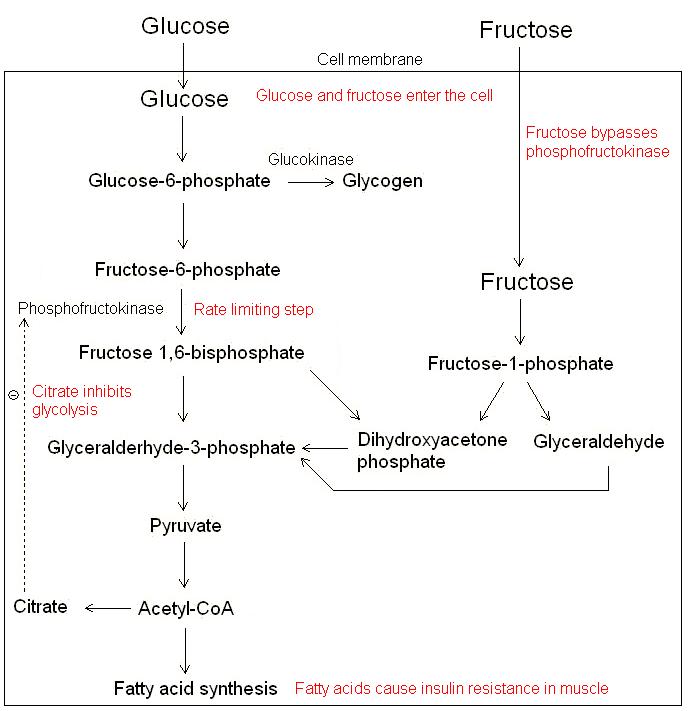Insulin resistance is a condition whereby the glucose uptake mechanisms in cells becomes resistant to the hormone insulin. Also called syndrome X or metabolic syndrome, it is characterised by weight gain and can lead over time to the development of type II diabetes and cardiovascular disease. Insulin resistance is a cause for concern because levels of obesity are rising. It is estimated that as many as 25 % of the adult populations in Western nations have insulin resistance. Diet is strongly implicated in the development of these metabolic problems. In particular, a high sugar content to the diet is the most likely contributor cause. Of particular interest to researchers is the link between high fructose diets and insulin resistance, as diets high in fructose have been shown to induce weight gain and insulin resistance in experimental animals.
After absorption fructose is transported to the liver where it is first phosphorylated to fructose-1-phosphate and then split into glyceraldehydes and dihydroxyacetone phosphate. These metabolites can then both enter glycolysis (figure 1). The importance of this metabolic step is that it bypasses the rate limiting step of glucose substrate glycolysis which is the enzyme phosphofructokinase. Citrate (product of glycolysis) inhibits both cellular glucose uptake and its flow through glycolysis (via phosphofructokinase inhibition) limiting further glycolysis. If high levels of fructose are consumed, the lack of regulatory control on its flow through glycolysis result in high amounts of unregulated acetyl-CoA production which results in the synthesis of non-esterified fatty acids (de novo lipogenesis). The ingestion of large amounts of fructose is therefore more likely to increase fatty acid production in the liver than the same amount of glucose.
 Figure 1. The metabolic fates of glucose and fructose in the liver. The rate limiting step in glycolysis (phosphofructokinase) is bypassed by fructose. High intakes of fructose therefore produce high amounts of non-esterified fatty acids in de novo lipogenesis. The amount of glucose converted to fatty acids will be less for glucose than fructose assuming equal feeding. This is because glucose is a fuel for all body cells and so much of the glucose will be taken up by other cells. Only the liver can metabolise fructose and so all the fructose will enter the liver. Fructose then has no regulatory control on its metabolism through glycolysis and so an abundance of acetyl-CoA will form and result in high amounts of fatty acid synthesis.
Figure 1. The metabolic fates of glucose and fructose in the liver. The rate limiting step in glycolysis (phosphofructokinase) is bypassed by fructose. High intakes of fructose therefore produce high amounts of non-esterified fatty acids in de novo lipogenesis. The amount of glucose converted to fatty acids will be less for glucose than fructose assuming equal feeding. This is because glucose is a fuel for all body cells and so much of the glucose will be taken up by other cells. Only the liver can metabolise fructose and so all the fructose will enter the liver. Fructose then has no regulatory control on its metabolism through glycolysis and so an abundance of acetyl-CoA will form and result in high amounts of fatty acid synthesis.
The hormone insulin is released in response to glucose ingestion, where it allows the glucose to enter the cells because it stimulate glucose transporters. Insulin also signals the central nervous system to inhibit further food intake and to provide feedback regarding energy intake. However, insulin is not released in response to fructose ingestion because the pancreas β-cells do not possess the fructose transporter GLUT5. High levels of fructose in the diet are therefore less likely to inhibit the satiety response than equivalent amounts of glucose. In the longer term, another hormone called leptin signals the body to prevent eating when adipose levels start to rise. Leptin is normally released in response to insulin stimulated glucose uptake in fat cells. Because fructose does not cause the release of insulin, consumption will down regulate leptin release which could result in over eating.
Consumption of fructose in thought to lead to insulin resistance because it causes an increase in non-esterified fatty acid production in the liver. These fatty acids can be incorporated into muscle tissue between the muscle cells, which is thought to be a major factor in the insulin resistance associated with fructose. In addition, high amounts of fructose in the liver are thought to lead to a reduction in liver sensitivity to glucose because fructose causes an inactivation of the hepatic insulin receptor. Insulin resistance in the muscle and liver then lead to an over secretion of insulin in response (hyperinsulinaemia). This causes an increase in fasting insulin levels and glucose levels typified by insulin resistance. In addition, the non-esterified fatty acids also have a detrimental effect on the β-cells in the pancreas that produce insulin.
Fructose is found in a wide range of common eaten natural foods including fruits. In addition, high-fructose corn syrup (HFCS) is a sweetener used in commercial preparation of many convenience foods. High-fructose corn syrup can contain roughly 50 % or more fructose, and tends to be added to soft drinks, sugary breakfast cereals, baked foods and other convenience foods such as cakes. It has been estimated that the average adults consumes around 15 grams of normal fructose per day and around 30 grams of high fructose corn syrup. It is unlikely that fruits are responsible for obesity. It is much more likely that the addition of large amounts of high-fructose corn syrup to our diets has resulted in a metabolic dysfunction with insulin resistance being the ultimate result. Convenience foods containing high fructose corn syrup have no place in a healthy diet.
RdB
